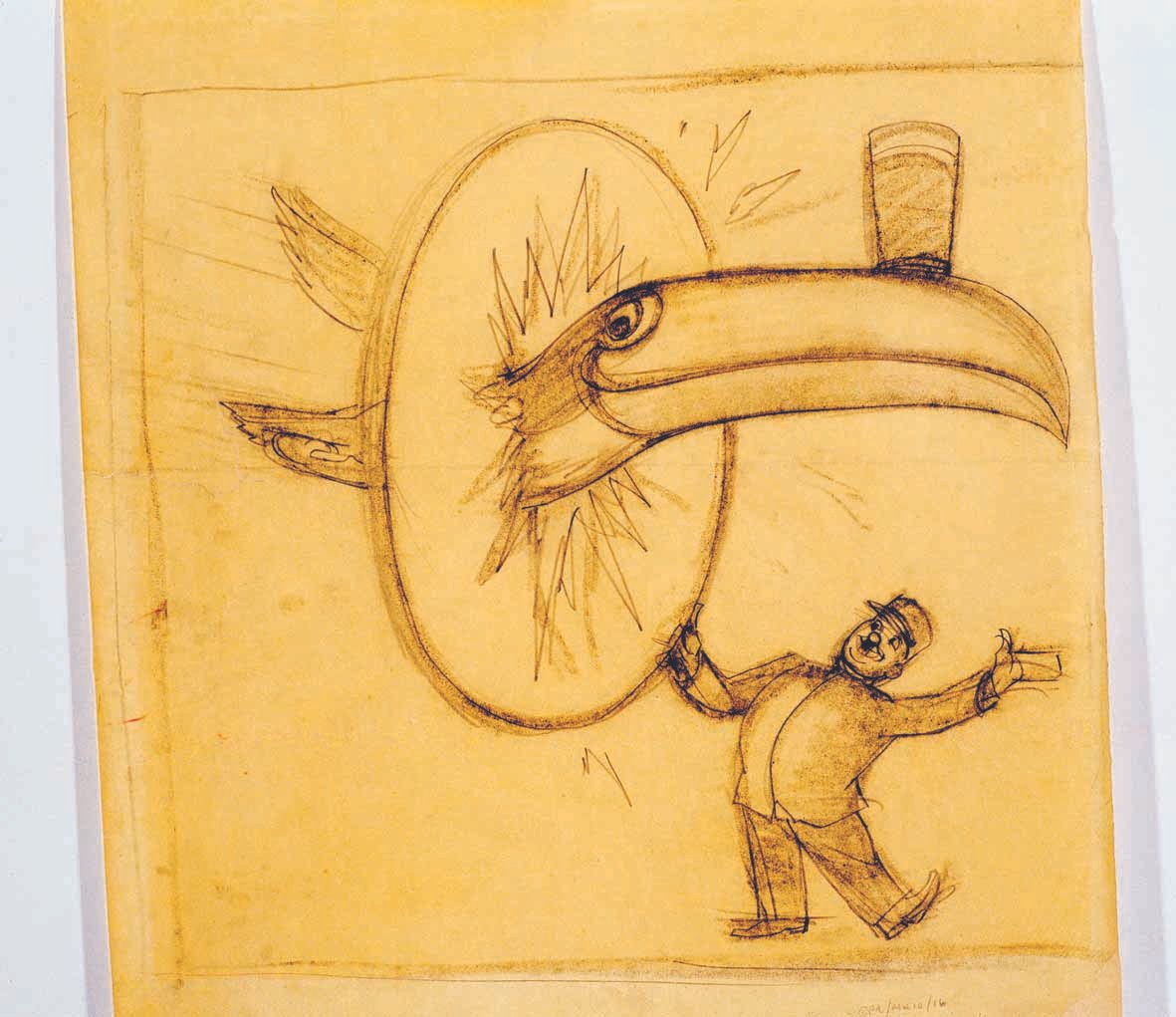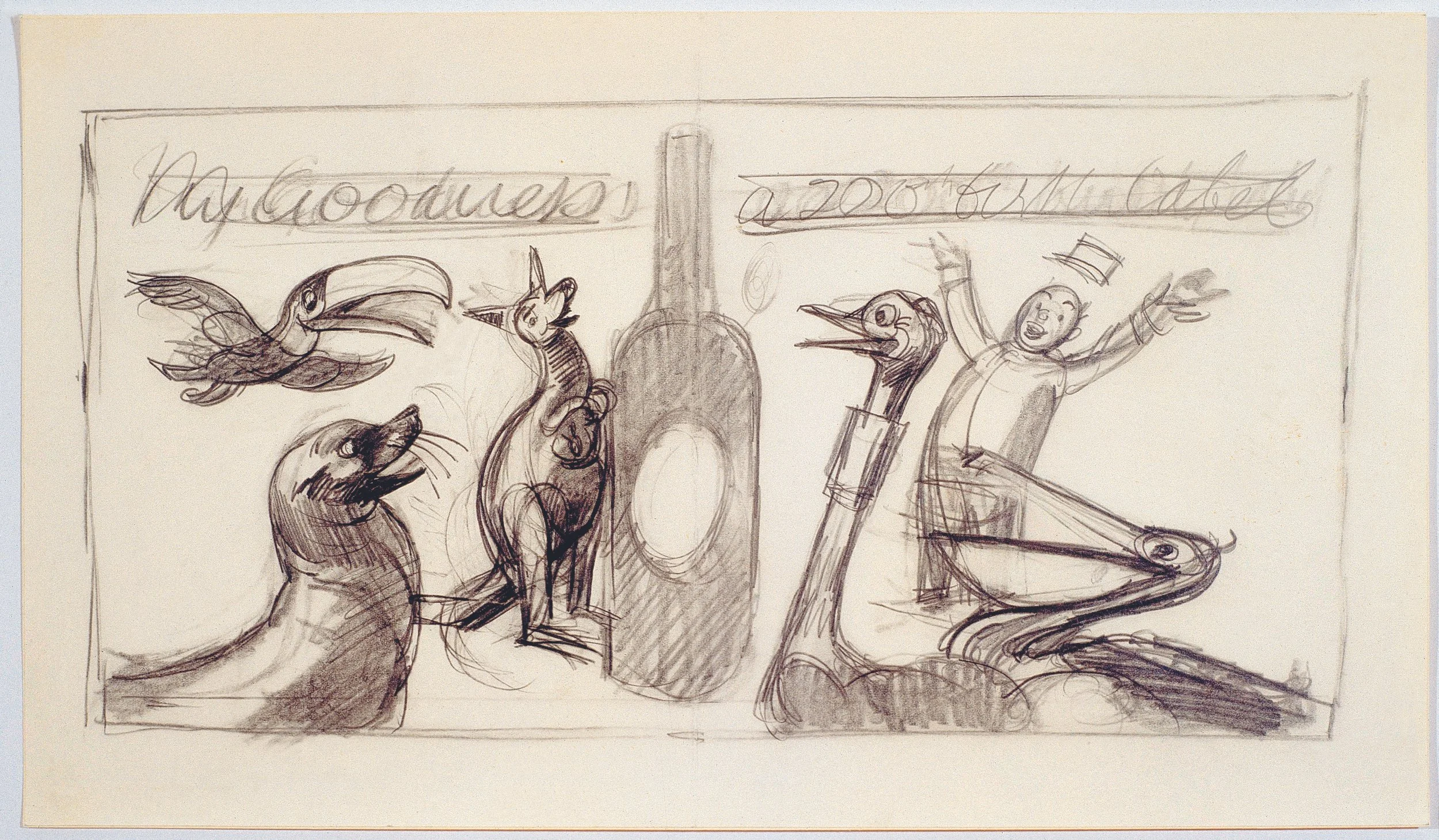Many thanks to Eibhlin Colgan, Archive and Heritage Manager at the Guinness Archive, St. James’s Gate, Dublin for providing the following content, images, and original John Gilroy sketches for this on-line exhibition.
John Gilroy (1898–1985): The Artist Behind the GUINNESS® Menagerie
John Gilroy was among the most gifted and prolific British artists of the 20th century. Celebrated for his contribution to commercial art, he created some of the most memorable and charming images in modern advertising while also maintaining a distinguished career as a portrait and landscape painter.
Following several successful poster designs, Gilroy joined S.H. Benson’s advertising agency in 1925. In 1928, the firm launched its first campaign for GUINNESS®, initiating a partnership that would define Gilroy’s career for the next three decades.
Gilroy’s artistry shaped two of GUINNESS®’s most influential and long-running campaigns. The first, “Guinness for Strength,” portrayed workers and athletes performing heroic feats—imbued with good humor and the suggestion that GUINNESS® provided both energy and fortitude. Among the best-known examples are the Girder (1934), showing a workman balancing a massive beam on his head, and the Horse and Cart (1949), featuring a farmer pulling his own wagon.
The second campaign, “My Goodness, My Guinness,” evolved from a moment of inspiration at the circus, when Gilroy imagined a sea lion balancing a pint of GUINNESS® on its nose. This idea gave rise to the famous series of zoo-animal posters, starring a hapless zookeeper—modeled on the artist himself—alongside a cast that included an ostrich, pelican, crocodile, tortoise, lion, kangaroo, giraffe, and the now-iconic toucan. Together, these images established a warm, humorous visual language that became synonymous with GUINNESS®.
During World War II, Gilroy continued producing advertising for the brand, adapting his lighthearted style to wartime themes. His designs appeared not only as posters but also across press advertisements, promotional merchandise, ceramic figures, and later, animated cinema and television commercials.
While his commercial art reached millions, Gilroy continued to view himself foremost as a portrait painter. His subjects included members of the British royal family, Sir Winston Churchill, Pope John XXIII, and numerous political and cultural figures. His extensive output—encompassing sketches, landscapes, greeting-card designs, and imaginative illustrations—reveals a restless creativity that blurred the lines between fine and commercial art.
John Gilroy’s work for GUINNESS® remains a landmark in 20th-century visual culture, exemplifying how wit, narrative, and design could transform advertising into an enduring form of popular art.
My Goodness! – Gilroy’s Guinness Zoo
Toucan / Pelican (1935)
The toucan—originally a pelican—was the first of Gilroy’s “Guinness Menagerie” to appear in poster form. The earliest design promoted the theme “Guinness-a-day” and featured a pelican balancing seven pints of GUINNESS® on its beak. It carried the humorous rhyme:
“A wonderful bird is the pelican,
Its bill can hold more than its belly can,
It can hold in its beak, enough for a week,
I simply don’t know how the hell he can.”
This concept was later revised by writer Dorothy L. Sayers, who replaced the pelican with a toucan and reduced the number of pints to two. The resulting advertisement read:
“If he can say as you can,
Guinness is good for you,
How grand to be a Toucan,
Just think what Toucan do!”
The toucan would go on to become one of the most enduring and recognizable symbols in GUINNESS® advertising.
Crocodile (1957)
The original sketch for this poster showed a crocodile shedding “crocodile tears,” but by the time the final version appeared, the creature had become far less tender-hearted. The crocodile’s grin grew progressively wider in subsequent versions—particularly in the extra-long format designed for bus-side advertisements.
Sea Lion (1935)
Gilroy claimed the idea for the sea lion—the very first of his animal designs—came after watching a performance at Bertram Mills’ Circus. Two decades later, on the first night of commercial television in Britain (22 September 1955), the first beer commercial to air featured a live sea lion waddling off with its keeper’s pint of GUINNESS®—a perfect real-life echo of Gilroy’s original poster.
Penguin
The penguin became the symbol for Draught GUINNESS® when it was first introduced to the British market. Chosen to emphasize the cool, refreshing character of the new draught beer, the penguin soon appeared on bar mounts, signage, and pub memorabilia throughout the 1950s.
Tortoise (1936)
The first tortoise poster depicted a surprisingly speedy tortoise carrying a pint of GUINNESS® with the slogan, “Have a Guinness when you’re tired.” This echoed the long-standing message that “Guinness is good for you,” emphasizing its restorative qualities.
The tortoise reappeared in a humorous Christmas booklet in 1937, accompanied by a playful rhyme:
“‘It’s Christmas,’ said the tortoise,
‘Have something good for you.’
So Guinness he has brought us,
And tortoise—what to do?”
Ostrich (1936)
The ostrich quickly became one of the most talked-about GUINNESS® animals. A flood of letters followed its debut, with viewers pointing out that the bird appeared to have swallowed its keeper’s glass upside down. Gilroy humorously explained that the ostrich had been imitating the sea lion—balancing the glass on its beak before flipping it into the air to swallow it.
A later 1952 press advertisement revived the character with a witty verse:
“The ostrich, travellers recall,
Enjoys his Guinness, glass and all.
How sad the Guinness takes so long,
To get to where it makes him strong!”
Zookeeper
The harried little zookeeper who appeared alongside the animals was, in fact, a self-caricature of John Gilroy himself. To reinforce the popularity of the animal theme, GUINNESS® sponsored real-life zoo and circus animals resembling those featured in Gilroy’s posters.









